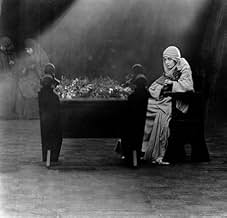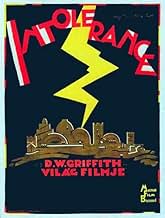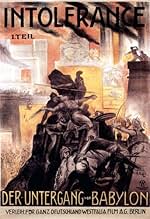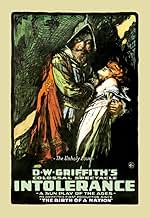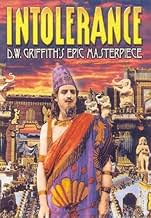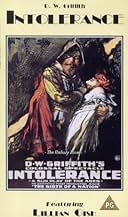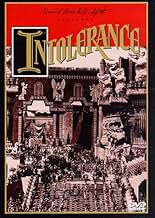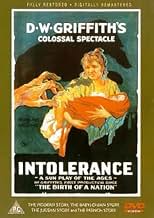CALIFICACIÓN DE IMDb
7.7/10
18 k
TU CALIFICACIÓN
La vida de una joven pobre, separada de su marido y su bebé por los prejuicios, se entremezcla con episodios de intolerancia a lo largo de la historia.La vida de una joven pobre, separada de su marido y su bebé por los prejuicios, se entremezcla con episodios de intolerancia a lo largo de la historia.La vida de una joven pobre, separada de su marido y su bebé por los prejuicios, se entremezcla con episodios de intolerancia a lo largo de la historia.
- Dirección
- Guionistas
- Elenco
- Premios
- 2 premios ganados en total
F.A. Turner
- The Dear One's Father
- (as Fred Turner)
Julia Mackley
- Uplifter
- (as Mrs. Arthur Mackley)
John P. McCarthy
- Prison Guard
- (as J.P. McCarthy)
Opiniones destacadas
My primary interest in this was as a foundation of cinema; so an academic interest, but - having influenced so many things I am very keen on - not without some excitement at the prospect of discovery of this early common source.
So much of cinema flows out from this; a host of recognizable names tutored on set - Von Stroheim, Tod Browning, Woody Van Dyke, Victor Fleming, Elmer Clifton, Jack Conway, King Vidor - and even more once the film rippled across the world. In Moscow, it was the raw material film students were given to dismantle in Lev Kuleshov's fledgling film school, the first ever. And in France Abel Gance must have been awe-struck by the sheer size of the canvas, if his own films offer any clue.
So yes, a fast-paced, lavish blockbuster - it cost at the time an unprecedented $2m to make - with literally a cast of thousands animating history, the story of Hollywood excess begins here - in Italy it had started earlier, with their Roman spectacles. The filmmaker as god, who does not simply photograph reality but constructs entire worlds, permits our vision to travel in the places that we could earlier only imagine.
But the fundamental technique is still from the theatre; that means a grand stage - elevated from us, separate - with every now and then a different backdrop, actors who pantomime sweeping emotion, the eye usually fixed in a distance. Oh the camera moves, but it moves with the stage. And what a grand stage it is.
I suppose it must have been desirable at the time when cinema, and so the possibilities of seeing, made the world feel so new and perhaps so alive again, when so many of the trials and heroism of the world narrative were yet to be immortalized in this new way, that a film like this should try to encompass so much; the Crucifixion, medieval France, ancient Babylon, they're all urgently envisioned in the same space.
It is in more ways than one that Griffith wrote the history of cinema then; by pioneering what he did in terms of a film language, but also by creating a vast expanse - a daunting 3 hours of film - that fills the prehistoric void, in terms of cinema, with a cachet of images, that creates a history of images. Now with the Pharisees or at the Persian camp of Cyrus, the court of Catherine or the harems of Babylon, common streets old and new; now we could point back and see, in a small measure, a history of film gathered in one place. So, when Kuleshov had tasked his students to rework the film, the choice was wise. There is so much here in terms of images, and so fertile for remodeling, that essentially he was presenting them with the empty sheet to write music on - that music, a deeply modernist product of synthesis, we called montage.
What does this filmmaker - as god - see though, what kind of worldview does he spring into life, this is more interesting I believe.
The title summarizes well. So, a cruel - but institutionalized, thus state sanctioned - evil threatening to engulf and dissolve all that is kind, which is the individual life, and of course the warm sentimentality that eventually restores faith in the personal struggle. But nothing casts a shadow in this world, no depth or dimension beyond the plainly conceivable. So the people are straight-forward beings, either good or bad - our heroine is simply called The Dear One - or misguided at their most complex; or, when en masse, they are part of the decor, collectively writhing in some extravagant background.
By the end, a heavenly chorus of angels illuminate the sky above a battlefield. The immediate contrast, like so much in the film, disarms with how much painstaking vision must have gone into making something so splendorous yet so naive. We can pretend like we ought to make amends with the time it was made, just like we can't pretend to look away with indifference, but the point remains; far more complex works of art had been made before, far less didactic about their humanitarian values.
You should at least see the segment with the siege of Babylon though, and the final scenes cross-cutting across time and space as we rush to the climax; it's things like these that so much was founded on.
(And another image that I recommend to those of you who have been charting all this; it is an inexplicable, tight close-up of the girl who is almost brushing, breathing into the camera. It happens once, and suggests intimacy that is never again encountered in the film. It's as though the girl, and so this cinema, is yearning to cross over into a new kind of film where faces hold all the mysteries and performances visualize innermost soul. Jean Epstein would make those films, ushering us in a new perception)
So much of cinema flows out from this; a host of recognizable names tutored on set - Von Stroheim, Tod Browning, Woody Van Dyke, Victor Fleming, Elmer Clifton, Jack Conway, King Vidor - and even more once the film rippled across the world. In Moscow, it was the raw material film students were given to dismantle in Lev Kuleshov's fledgling film school, the first ever. And in France Abel Gance must have been awe-struck by the sheer size of the canvas, if his own films offer any clue.
So yes, a fast-paced, lavish blockbuster - it cost at the time an unprecedented $2m to make - with literally a cast of thousands animating history, the story of Hollywood excess begins here - in Italy it had started earlier, with their Roman spectacles. The filmmaker as god, who does not simply photograph reality but constructs entire worlds, permits our vision to travel in the places that we could earlier only imagine.
But the fundamental technique is still from the theatre; that means a grand stage - elevated from us, separate - with every now and then a different backdrop, actors who pantomime sweeping emotion, the eye usually fixed in a distance. Oh the camera moves, but it moves with the stage. And what a grand stage it is.
I suppose it must have been desirable at the time when cinema, and so the possibilities of seeing, made the world feel so new and perhaps so alive again, when so many of the trials and heroism of the world narrative were yet to be immortalized in this new way, that a film like this should try to encompass so much; the Crucifixion, medieval France, ancient Babylon, they're all urgently envisioned in the same space.
It is in more ways than one that Griffith wrote the history of cinema then; by pioneering what he did in terms of a film language, but also by creating a vast expanse - a daunting 3 hours of film - that fills the prehistoric void, in terms of cinema, with a cachet of images, that creates a history of images. Now with the Pharisees or at the Persian camp of Cyrus, the court of Catherine or the harems of Babylon, common streets old and new; now we could point back and see, in a small measure, a history of film gathered in one place. So, when Kuleshov had tasked his students to rework the film, the choice was wise. There is so much here in terms of images, and so fertile for remodeling, that essentially he was presenting them with the empty sheet to write music on - that music, a deeply modernist product of synthesis, we called montage.
What does this filmmaker - as god - see though, what kind of worldview does he spring into life, this is more interesting I believe.
The title summarizes well. So, a cruel - but institutionalized, thus state sanctioned - evil threatening to engulf and dissolve all that is kind, which is the individual life, and of course the warm sentimentality that eventually restores faith in the personal struggle. But nothing casts a shadow in this world, no depth or dimension beyond the plainly conceivable. So the people are straight-forward beings, either good or bad - our heroine is simply called The Dear One - or misguided at their most complex; or, when en masse, they are part of the decor, collectively writhing in some extravagant background.
By the end, a heavenly chorus of angels illuminate the sky above a battlefield. The immediate contrast, like so much in the film, disarms with how much painstaking vision must have gone into making something so splendorous yet so naive. We can pretend like we ought to make amends with the time it was made, just like we can't pretend to look away with indifference, but the point remains; far more complex works of art had been made before, far less didactic about their humanitarian values.
You should at least see the segment with the siege of Babylon though, and the final scenes cross-cutting across time and space as we rush to the climax; it's things like these that so much was founded on.
(And another image that I recommend to those of you who have been charting all this; it is an inexplicable, tight close-up of the girl who is almost brushing, breathing into the camera. It happens once, and suggests intimacy that is never again encountered in the film. It's as though the girl, and so this cinema, is yearning to cross over into a new kind of film where faces hold all the mysteries and performances visualize innermost soul. Jean Epstein would make those films, ushering us in a new perception)
This silent film by director D.W. Griffith is well known to serious movie buffs and historians, but not to today's general public. I doubt that a lot of people these days would have the patience to sit through a film that contained three hours of silence. Nevertheless, the film's technical innovations inspired filmmakers in the 1920's and later, particularly in Russia and Japan. It also inspired filmmakers in the U.S., including Cecil B. DeMille and King Vidor. For this reason, and for other reasons, "Intolerance" is an important film.
The film's four interwoven stories, set in four different historical eras, are tied together thematically by the subject of "intolerance", a word which could be accurately interpreted today as "oppression", "injustice", "hate", "violence", and mankind's general inhumanity.
Griffith's narrative structure, though innovative, is uneven, because he gives more screen time to two of the four stories (the "modern" and the "Babylonian"). Equal time for three stories, thus deleting the fourth, might have worked better.
To me, the Babylonian story is the most interesting one because of its more complete coverage, and because of its elaborate costumes and spectacular sets. Even though there is no script, the viewer can easily discern the plot, which suggests that some of today's films might be just as effective, or more so, if screenwriters would downsize the dialogue.
What "Intolerance" offers most of all to contemporary viewers is a sense of perspective. Someone once said that despite the enormous advances in technology, society itself has advanced not at all. That may be true. In the eighty plus years since the film was released, technical advances in film-making have been obvious and impressive. But we are still plagued with the same old human demons of oppression, injustice, hate, violence, and ... intolerance.
The film's four interwoven stories, set in four different historical eras, are tied together thematically by the subject of "intolerance", a word which could be accurately interpreted today as "oppression", "injustice", "hate", "violence", and mankind's general inhumanity.
Griffith's narrative structure, though innovative, is uneven, because he gives more screen time to two of the four stories (the "modern" and the "Babylonian"). Equal time for three stories, thus deleting the fourth, might have worked better.
To me, the Babylonian story is the most interesting one because of its more complete coverage, and because of its elaborate costumes and spectacular sets. Even though there is no script, the viewer can easily discern the plot, which suggests that some of today's films might be just as effective, or more so, if screenwriters would downsize the dialogue.
What "Intolerance" offers most of all to contemporary viewers is a sense of perspective. Someone once said that despite the enormous advances in technology, society itself has advanced not at all. That may be true. In the eighty plus years since the film was released, technical advances in film-making have been obvious and impressive. But we are still plagued with the same old human demons of oppression, injustice, hate, violence, and ... intolerance.
Everything about this movie is fascinating, even its numerous flaws. It is as ambitious a movie as has ever been made, and if you adjust for the era, it might also be the most lavish, expensive, and painstaking. Even today the scope and detail stand out, despite the many technical limitations in its era. Likewise, the enormous cast list contains many names that silent film fans will recognize at once, with well-known performers even in some of the minor roles. Then, you could write many pages about the stories, which are filled with weaknesses, but which are also so interesting that you never want to miss what will happen next.
The concept behind "Intolerance" is as enterprising as it gets: no fewer than four complete, independent story-lines, with the movie switching back-and-forth among them, not necessarily in consecutive order but with a definite plan in mind, all in order to get across the idea suggested by the title - that is, that intolerance of others' beliefs or lifestyles has been a destructive force throughout history. It is generally understood that there is a strong dose of defensiveness behind this plan, since the ideas promoted in Griffith's previous film had earned for him some severe and well-justified criticism. This personal motivation could well explain why "Intolerance" is often so overblown, and it also is interesting in light of the stories chosen to illustrate the main themes.
The two most straightforward stories - the persecution of the Huguenots in 16th century France, and the persecution of Jesus Christ by the religious leaders of his day - are also the most believable, and yet they do not seem to get quite the screen time or the lavish detail of the other two. The contemporary story may have been the most important to Griffith, and it is a full-scale melodrama, full of heavy-handed developments and very unlikely coincidences, yet certainly a story that will hold your attention. The Babylonian story is at once the strangest choice, the most extravagant, and the most fascinating of all. As history, it is as distorted as (or more so than) any of today's movies. Trying to pass off Belshazzar of Babylon as a model of justice and tolerance is just weird, and the entire historical scenario is at best an imaginative embellishment of the truth. But the involved story that Griffith tells in this setting is so exciting and entertaining that you just can't take your eyes away from it.
Much, much more could be said, but anyone with an interest in silent movies or in cinema history will want to watch it and draw his or her own conclusions. Whether you want to analyze the vast array of themes, events, and ideas, or whether you just want to sit back and enjoy a fascinating spectacle, the three hours fly by very quickly, and it's a movie you won't forget.
The concept behind "Intolerance" is as enterprising as it gets: no fewer than four complete, independent story-lines, with the movie switching back-and-forth among them, not necessarily in consecutive order but with a definite plan in mind, all in order to get across the idea suggested by the title - that is, that intolerance of others' beliefs or lifestyles has been a destructive force throughout history. It is generally understood that there is a strong dose of defensiveness behind this plan, since the ideas promoted in Griffith's previous film had earned for him some severe and well-justified criticism. This personal motivation could well explain why "Intolerance" is often so overblown, and it also is interesting in light of the stories chosen to illustrate the main themes.
The two most straightforward stories - the persecution of the Huguenots in 16th century France, and the persecution of Jesus Christ by the religious leaders of his day - are also the most believable, and yet they do not seem to get quite the screen time or the lavish detail of the other two. The contemporary story may have been the most important to Griffith, and it is a full-scale melodrama, full of heavy-handed developments and very unlikely coincidences, yet certainly a story that will hold your attention. The Babylonian story is at once the strangest choice, the most extravagant, and the most fascinating of all. As history, it is as distorted as (or more so than) any of today's movies. Trying to pass off Belshazzar of Babylon as a model of justice and tolerance is just weird, and the entire historical scenario is at best an imaginative embellishment of the truth. But the involved story that Griffith tells in this setting is so exciting and entertaining that you just can't take your eyes away from it.
Much, much more could be said, but anyone with an interest in silent movies or in cinema history will want to watch it and draw his or her own conclusions. Whether you want to analyze the vast array of themes, events, and ideas, or whether you just want to sit back and enjoy a fascinating spectacle, the three hours fly by very quickly, and it's a movie you won't forget.
I saw a four hour, ten minute version of this as the University of Chicago's Ida Noyes Hall in February, 1993 -- restored with stills and copyright photos, with a new score by Gillian Anderson, featuring the composer conducting the University Symphony Orchestra -- what an experience!
And where, oh where, is this restored version to be seen today?
Somebody get on the copyright owner's case to release the 4:10 version, with Gillian Anderson's score!
This fine film, possibly the quintessential Griffith, has been in the shadow of the notorious Birth of a Nation too long. (Of course, without Birth of a Nation's controversy, this might never have been made). Intolerance has more spectacle than Birth, far more "speaking" parts (if that's not an oxymoron, I don't know what is!), and is far more PC -- but not in a negative way.
See it, in any form you can!
And where, oh where, is this restored version to be seen today?
Somebody get on the copyright owner's case to release the 4:10 version, with Gillian Anderson's score!
This fine film, possibly the quintessential Griffith, has been in the shadow of the notorious Birth of a Nation too long. (Of course, without Birth of a Nation's controversy, this might never have been made). Intolerance has more spectacle than Birth, far more "speaking" parts (if that's not an oxymoron, I don't know what is!), and is far more PC -- but not in a negative way.
See it, in any form you can!
"Intolerance" is D.W. Griffith's apologia for "The Birth of a Nation" mostly in that it surpasses its predecessor's epic scale, thus replying to his critics. "The Birth of a Nation" was a racist film, and nothing in "Intolerance" proves otherwise, but I don't think that's the point, either. And, while Griffith calls his critics hypocrites, it's just as easy to call Griffith one for his racism. Yet, I have no disagreement that his films are art despite their messages. "Intolerance" contains much more agreeable views than "The Birth of a Nation", anyhow: Christian pacifism; support of labor; moderated progressivism; and condemnation of intolerance, hatred and inhumanity throughout the ages.
The narrative structure of "Intolerance" was revolutionary and particularly surprising for a filmmaker who had cemented in cinema a traditional and theatrical form of linear storytelling with his previous work. In "Home, Sweet Home" (1914), Griffith linked four separate stories with a single theme, but with each story told in full before proceeding to the next. With "Intolerance", he employed parallel editing, thus continually crosscutting between time, suspending plots and commenting on stories with other stories, and I think it's ingeniously congruent considering the stories are supposed to run parallel in their morals, or messages on the general theme of intolerance.
The four stories include a modern story, which features a fictional representation of the Ludlow massacre of strikers and a progressive era foundation of busybody reformers that indirectly causes the massacre and directly applies suffering on the central characters. It was originally intended as a complete film in itself and was later released as such under the title "The Mother and the Law". Then, there's the Babylonian story, which was also released by itself, as "The Fall of Babylon". It almost seems to be more likely to have been directed by Cecil B. DeMille than by D.W. Griffith, for all its sex and exotic set design against a historical setting. A contemporary of Griffith, however, DeMille had not yet figured out that formula and may well have been thinking of the Babylonian sequences in "Intolerance" when he did; one of his early pictures and first attempts at an epic, "Joan the Woman" (1917), does demonstrate Griffith's influence on him. Additionally, the sequence features the best performance in the film by ingénue Constance Talmadge as the "Mountain Girl". She, too, seems out of place in a Griffith production, with her sexuality, impropriety and independence. The lesser stories of Christ's life and his crucifixion and the events leading up to the St. Bartholomew's Day Massacre aren't especially interesting in themselves, as many have panned. Yet, I don't think that's essential, as they don't stand by themselves, but are part of a whole where they comment on and run parallel to each other and the other narratives.
The stories are connected by explanatory, as well as moralizing and poetical, intertitles and by glimpses of Lillian Gish endlessly rocking the cradle (taken from Walt Whitman). Reportedly, tinting also separated the stories upon initial release. Nearing the climax, however, these separations and transitions evaporate for an ever more merging and rapider plot. "Intolerance" is the apex of Griffith's innovations and developments in editing--the culmination of his achievements in "The Birth of a Nation" and his last-minute-rescue pictures and other Biograph shorts. Along the way, it was usually James and Rose Smith who aided him in the editing room. Doubtless, these achievements, especially in "Intolerance", greatly influenced the Soviet and European montage filmmakers, as well as subsequent filmmaking in general.
With the astounding success of "The Birth of a Nation", Griffith had the opportunity to make almost any film he wanted, and with "Intolerance" having cost nearly $400,000 to make, he did. (The some $100,000 budget for "The Birth of a Nation" had been unheard of in Hollywood.) The film's failure financially ruined Triangle Studios and considerably altered and limited Griffith's filmmaking career from thereon. As "The Birth of a Nation" demonstrated to Hollywood and the world how profitable and popular cinema could be, "Intolerance" told another important lesson on the risks and limitations involved.
Consuming much of the film's budget were Walter L. Hall's Babylon sets, and they are spectacular. They're also surprisingly imaginative and elaborate for D.W. Griffith, whose stagy, open-air sets in previous productions were generally unremarkable--besides those in "Judith of Bethulia" (1914), which pale in comparison. The influence of "Cabiria" (1914) is very evident, but where that film failed to equal the brilliance of its sets with the filming of them, "Intolerance" succeeds. The legendary crane shots are standouts.
Throughout the film, cinematographer "Billy" Bitzer masks the camera lens--more extensively than ever before--creating iris shots, a moving iris shot within a stationary shot and small-scale widescreen effects. Griffith and Bitzer are very much in control of the images, establishing us as spectators. The Babylonian scenes where characters look down at miniatures of the city, I think, also add to this emphasis. And, "Intolerance" is quite a spectacle, especially the Babylonian scenes. Overall, the cinematography, such as some extreme close-ups, is innovative and advanced. Additionally, Griffith and Bitzer once again proved themselves masters of filming battle scenes.
"Cabiria" and the other Italian epics were a great impetus for Griffith to have embarked on his own two epic masterpieces, but the Italian epics were merely super-theatrical, with "Cabiria" as its apex and somewhat of a bridge to Griffith making the epic a cinematic art and a cornerstone of the industry. Moreover, from his pioneering short films at Biograph, to the epics "The Birth of a Nation" and "Intolerance", and to a lesser extent, his work thereafter, nobody has had a greater influence on the course cinema would take than D.W. Griffith.
The narrative structure of "Intolerance" was revolutionary and particularly surprising for a filmmaker who had cemented in cinema a traditional and theatrical form of linear storytelling with his previous work. In "Home, Sweet Home" (1914), Griffith linked four separate stories with a single theme, but with each story told in full before proceeding to the next. With "Intolerance", he employed parallel editing, thus continually crosscutting between time, suspending plots and commenting on stories with other stories, and I think it's ingeniously congruent considering the stories are supposed to run parallel in their morals, or messages on the general theme of intolerance.
The four stories include a modern story, which features a fictional representation of the Ludlow massacre of strikers and a progressive era foundation of busybody reformers that indirectly causes the massacre and directly applies suffering on the central characters. It was originally intended as a complete film in itself and was later released as such under the title "The Mother and the Law". Then, there's the Babylonian story, which was also released by itself, as "The Fall of Babylon". It almost seems to be more likely to have been directed by Cecil B. DeMille than by D.W. Griffith, for all its sex and exotic set design against a historical setting. A contemporary of Griffith, however, DeMille had not yet figured out that formula and may well have been thinking of the Babylonian sequences in "Intolerance" when he did; one of his early pictures and first attempts at an epic, "Joan the Woman" (1917), does demonstrate Griffith's influence on him. Additionally, the sequence features the best performance in the film by ingénue Constance Talmadge as the "Mountain Girl". She, too, seems out of place in a Griffith production, with her sexuality, impropriety and independence. The lesser stories of Christ's life and his crucifixion and the events leading up to the St. Bartholomew's Day Massacre aren't especially interesting in themselves, as many have panned. Yet, I don't think that's essential, as they don't stand by themselves, but are part of a whole where they comment on and run parallel to each other and the other narratives.
The stories are connected by explanatory, as well as moralizing and poetical, intertitles and by glimpses of Lillian Gish endlessly rocking the cradle (taken from Walt Whitman). Reportedly, tinting also separated the stories upon initial release. Nearing the climax, however, these separations and transitions evaporate for an ever more merging and rapider plot. "Intolerance" is the apex of Griffith's innovations and developments in editing--the culmination of his achievements in "The Birth of a Nation" and his last-minute-rescue pictures and other Biograph shorts. Along the way, it was usually James and Rose Smith who aided him in the editing room. Doubtless, these achievements, especially in "Intolerance", greatly influenced the Soviet and European montage filmmakers, as well as subsequent filmmaking in general.
With the astounding success of "The Birth of a Nation", Griffith had the opportunity to make almost any film he wanted, and with "Intolerance" having cost nearly $400,000 to make, he did. (The some $100,000 budget for "The Birth of a Nation" had been unheard of in Hollywood.) The film's failure financially ruined Triangle Studios and considerably altered and limited Griffith's filmmaking career from thereon. As "The Birth of a Nation" demonstrated to Hollywood and the world how profitable and popular cinema could be, "Intolerance" told another important lesson on the risks and limitations involved.
Consuming much of the film's budget were Walter L. Hall's Babylon sets, and they are spectacular. They're also surprisingly imaginative and elaborate for D.W. Griffith, whose stagy, open-air sets in previous productions were generally unremarkable--besides those in "Judith of Bethulia" (1914), which pale in comparison. The influence of "Cabiria" (1914) is very evident, but where that film failed to equal the brilliance of its sets with the filming of them, "Intolerance" succeeds. The legendary crane shots are standouts.
Throughout the film, cinematographer "Billy" Bitzer masks the camera lens--more extensively than ever before--creating iris shots, a moving iris shot within a stationary shot and small-scale widescreen effects. Griffith and Bitzer are very much in control of the images, establishing us as spectators. The Babylonian scenes where characters look down at miniatures of the city, I think, also add to this emphasis. And, "Intolerance" is quite a spectacle, especially the Babylonian scenes. Overall, the cinematography, such as some extreme close-ups, is innovative and advanced. Additionally, Griffith and Bitzer once again proved themselves masters of filming battle scenes.
"Cabiria" and the other Italian epics were a great impetus for Griffith to have embarked on his own two epic masterpieces, but the Italian epics were merely super-theatrical, with "Cabiria" as its apex and somewhat of a bridge to Griffith making the epic a cinematic art and a cornerstone of the industry. Moreover, from his pioneering short films at Biograph, to the epics "The Birth of a Nation" and "Intolerance", and to a lesser extent, his work thereafter, nobody has had a greater influence on the course cinema would take than D.W. Griffith.
¿Sabías que…?
- TriviaDuring filming of the battle sequences, many of the extras got so into their characters that they caused real injury to one another. At the end of one shooting day, a total of 60 injuries were treated at the production's hospital tent.
- ErroresOne of the early title cards in the Judean sequence refers to Jesus having been from "the carpenter shop in Bethlehem". Though he was born in Bethlehem, he worked with his father in a carpenter shop in Nazareth, which is why he was known as Jesus of Nazareth.
- Citas
Intertitle: When women cease to attract men, they often turn to reform as a second option.
- Créditos curiososConstance Talmadge is credited as 'Georgia Pearce' for her performance as Marguerite de Valois in the French Story. She is credited under her own name in the role of The Mountain Girl in the Babylonian Story.
- Versiones alternativasThe movie was officially restored in 1989 by Kevin Brownlow and David Gill for Thames Television. It was transferred from the best available 35mm materials, color-tinted per D.W. Griffith's intent, and contains a digitally recorded orchestral score by Carl Davis. This 176-minute version was released on video worldwide, but has never been telecast in the U.S.
- ConexionesEdited into The Fall of Babylon (1919)
Selecciones populares
Inicia sesión para calificar y agrega a la lista de videos para obtener recomendaciones personalizadas
- How long is Intolerance?Con tecnología de Alexa
Detalles
Taquilla
- Presupuesto
- USD 385,907 (estimado)
- Tiempo de ejecución2 horas 43 minutos
- Mezcla de sonido
- Relación de aspecto
- 1.33 : 1
Contribuir a esta página
Sugiere una edición o agrega el contenido que falta


